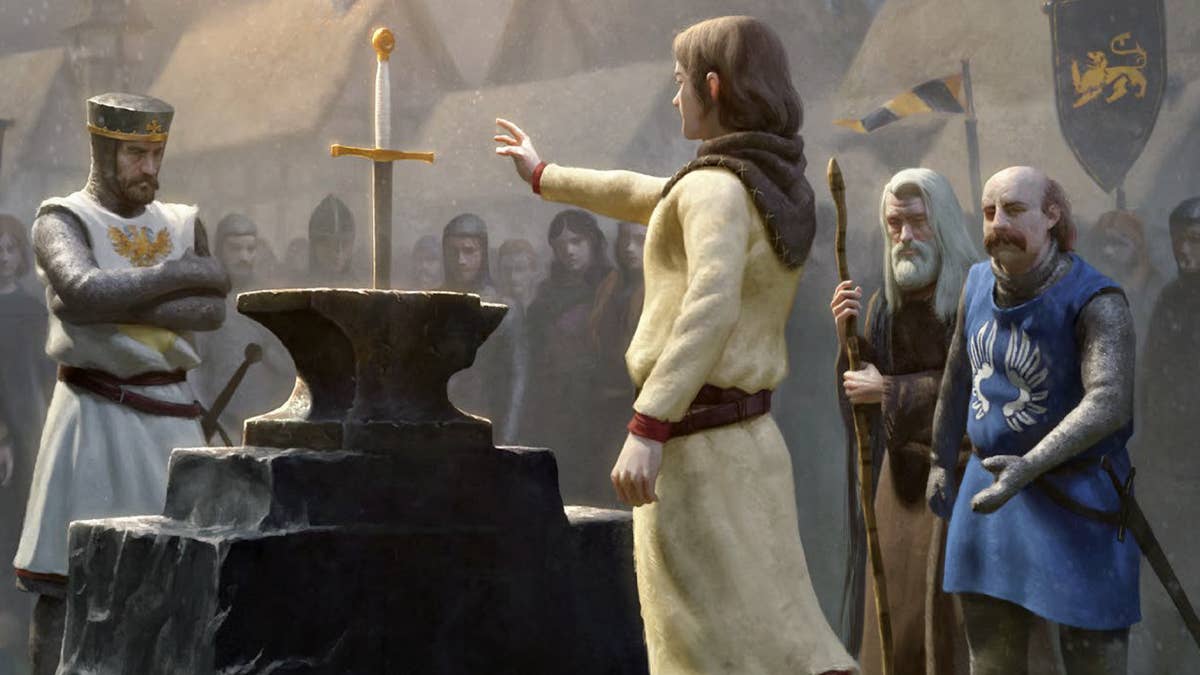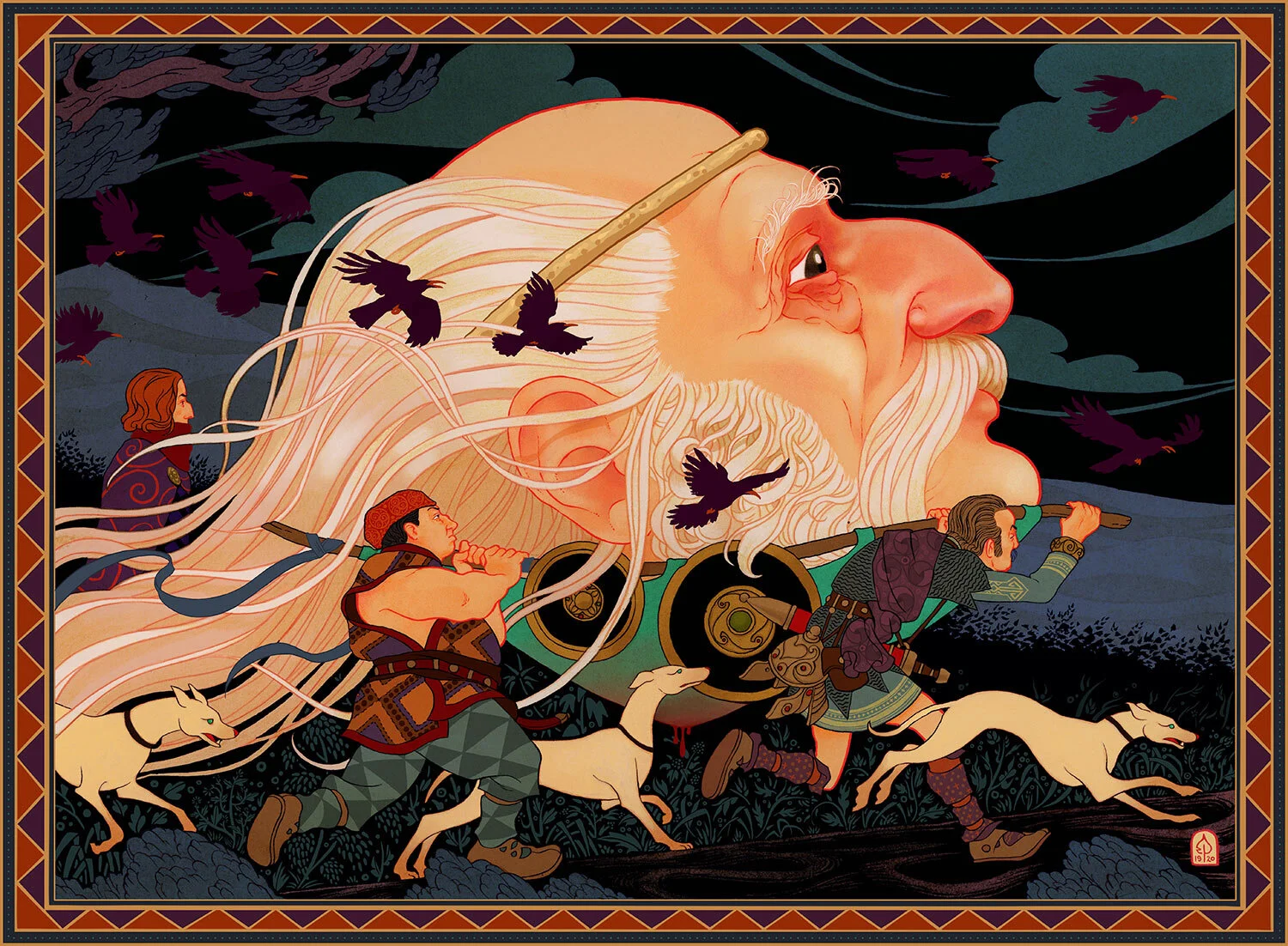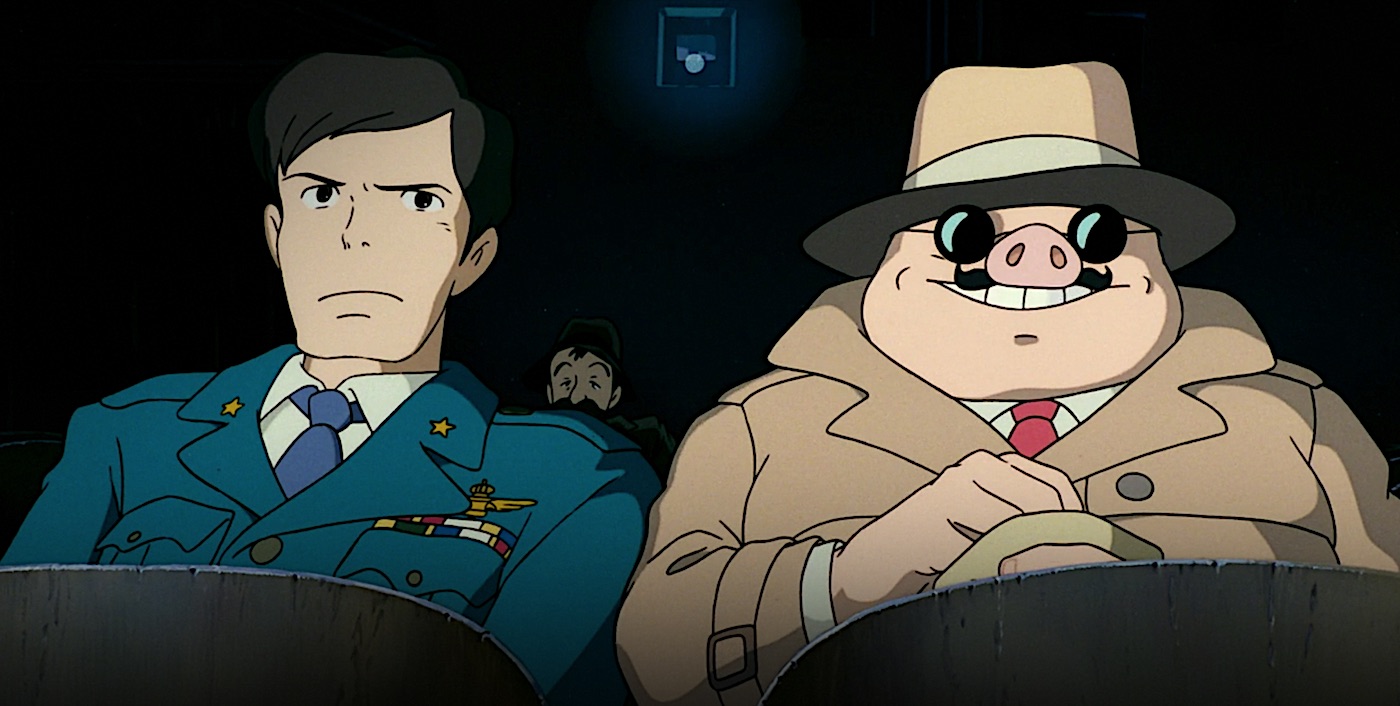Pendragon Play Report - Year 1, Sessions 1 & 2

This is a summary of the first year of the reign of King Arthur in my Pendragon game, which took place over the course of 3 sessions: one for setting up the characters and their family history, and two of playing.
The characters are Sir Eogrim - a chill lazybones with a penchant for lying - and his cousin and squire, Elias - a very Christian young lad of 18.
The Family History
This was a confusing bit, because I thought of using HârnMaster for the game, but then I walked it back and changed it to Pendragon at the last minute.
In Pendragon, we usually have a "Family History" where we roll 1d20 per year to check what happens to your ancestor, and then gain Glory depending on what happens.
The Family History lasted for about 3 hours. They decided to make the characters cousins, so they shared their grandfather and then rolled for their father.
This was by text, by voice it might have gone a bit faster, but that's roughly the ballpark. I like doing these because it gives the player a lot of context to the world: your grandfather fought against these guys, then you see your dad fighting them, and when they inevitably show up in game, it feels natural and expected.
The unfortunate part is that it takes a bit out of the players. Some players enjoy it, but many others in my experience think this is overlong and a bit unnecessary.
Either way, this generated interesting material, and so we went for the character creation, which was a lot faster, and on to the first session.
Session 1: The Tournament of the Sword

Pendragon has a yearly structure: a (mostly optional) Spring Court where the knights are introduced to what is the current problem and assigned their duties, or told they can go errant; Adventuring Season (summer) where the game actually happens; and then the Winter Phase, which is downtime, where the character improvement happens.
This structure is baked into the game since at least 1997, but probably comes from even before that. Since then, there have been a few books that introduce a timeline of events and suggestions of what happens that year. The biggest of these is the Grand Pendragon Campaign [GPC], a humongous thing that starts in 485 AD (expanded to 480 in 2015) during the generation of Arthur's dad, and ends in 566 AD, when everybody is dead or dying.
Recently Chaosium has been shaking it up. They released the Sword Campaign as part of the Pendragon 6 Starter Set, which includes the reworked years 510, 511, and 512, and the Adventure of the Grey Knight, which completes the timeline up to 515.
I have elected to mix them up, because there are things from both that I enjoy and from both that I dislike.
Early Spring, in London
During Easter, Sir Eogrim and Elias arrived at London for the Tournament of the Sword, organized by the Archbishop of London (since Canterbury is occupied by the vikings), with the grand prize being the throne of England to whoever wins the tournament. The kingdom has been without a king, and Britain without a High King, ever since Uther died 15 years ago, and this is the Archbishop's attempt at putting an end to the Anarchy.
- DM Commentary: Very loaded setup. The GPC kinda assumes the players will have been playing up to this point, but I find that starting an Arthur game with Arthur is better for longevity. Plus, I swapped the enemies from "invading Anglo-Saxons" to Vikings, and removed it from the pretense of it being set during the 500's and, instead, set it somewhere unspecified in the distant past.
They arrived at the courtyard of St. Paul's Cathedral to see the Sword in the Stone (which is actually embedded in an anvil upon the stone) but also to talk to the Lord Marshall of London to enlist on the tournament.

In the courtyard they recognize with a roll Lot, High King of Scotland1, his wife, a few of their children and one boy who is their nephew, but our players don't know that yet.
Eogrim attempts to draw the sword just for sport and the prince-squires make fun of him. He loses his cool and insults their heritage, which prompts their hotheaded cousin to try something, but the princes hold him back and Eogrim apologizes to an unimpressed crowd.
From here, the both get a few options of interesting places to visit in London and are told that they can visit 2 of them.
- DM Commentary: I elaborate on this in the Shop Talk, but I'm not a huge fan of just giving the players a list of places to go. On the other hand, it's not that different from saying that a room in a dungeon only has 4 exits. I'm conflicted.
The Jewish Quarter
They start by going to the Jewish Quarter, just to see how people live, and witness a knight being arrested by Leodegrance, King of Cameliard, seemingly for having stolen bread. This king exchanges a few words with them and they get to join his team for the grand melee.
Afterwards they decide to ask around about the knight and pay the merchant for whatever the knight had stolen. The merchant, Samuel, invites them for lunch at his house where they meet his daughter, Joiette, but just make casual conversation.
The Pen Brân
Following that they decide to go to the Pen Brân, a field outside of London where it is said that the head of the god Brân the Blessed is buried to protect the British Isles from... something. Maybe invasion?
Arriving there they meet a knight with a shaved head playing harp under a tree, and found out he's called Morholt2, or The Morholt, and is an errant knight from Ireland. The Morholt tells them the story of Brân after some pleasant chatter and they go back to the inn.
There they're put inside a room with 2 other men and their squires, who introduce themselves as Sir Ector and his sons, Sir Kay, Kay's squire Wart, and Ector's squire Arcturus, a beautiful lad blonde like Ector and Kay. They find out they're also on Leodegrance's team and the 6 become fast acquaintances.
- DM Commentary: In hindsight, heavy-handed, but I think it's kinda quaint. I wanted them to meet on the lineup for the tournament right after this, but I decided against.

The Tournament Proper
In the morning, they march up to the tournament with Ector's family where there's the parade of the knights through the city and to the tournament place, the Helm Show where the judges check for scoundrels in the crowd, and the start of the Grand Melee.
From the outset, right on the first round, Eogrim almost knocks down another knight. On his side, Kay is fighting with the Morholt and gets so angry that he breaks his sword on the Morholt's head. The irish knight gets even angrier and jumps at him from his horse, dagger drawn.
Sir Eogrim decides to intervene with his horse, drawing the two apart and helping Wart drag him back to the stands. There, Kay asks Wart to go and get him another sword; Elias comes with.
Wart brings Elias the sword, and he very quickly recognizes that it's the Sword in the Stone from earlier. Elias starts panicking about putting it back, but Wart goes up to Kay and presents the sword. Shenanigans ensue.
- DM Commentary: Again, just a cute, if cheap misdirection. Arcturus is actually Bedivere, but no one knows him so it wouldn't be much of a reveal. More importantly, notice how Eogrim and Elias are just following along. I'll mention it later, during the Shop Talk.
Ector comes to see Kay, Kay says he drew the sword, Eogrim agrees, Elias says that liars go to hell, all of them go up to St. Paul's and Ector tells Kay to put the sword back whereupon Kay admits he didn't actually draw it himself. Wart is revealed to be Arthur.
The book goes indepth into this cutscene but I sped along it a bit. Arthur draws the sword in front of a few barons, High King Lot rebukes him and leaves, and Arthur makes most of the detached knights his household knights, including Eogrim.3
High Spring, in the Dark
The Sword from the Stone, called Clarent, is put inside St. Paul's for safekeeping while Arthur arranges for his proper coronation at Cair Lion (Caerleon, near Newport in Wales).
The knights from his household are put as guards there in case anyone tries to steal it, and Eogrim is among them. Wouldn't you know it, someone does show up - "painted men", apparently Scottish Highlanders, but they don't seem like actual people in the shadows, morphing and moving around almost like monkeys, only taking man shape in the light.
Are these something weird or are the people from the Scottish Highlands just like this in this world? Maybe we'll never know.4
Either way, two of these Painted Men jump Eogrim, who gets immediately stabbed and takes a Major Wound, which means he's mostly unconscious and unable to fight. Cool, I love it when the players are taken out in the first round.
One of the Painted Men takes this opportunity to run and grab the sword. Elias tries to get in his way but is slowed by his armour. The Painted Man almost makes his way out but Eogrim grabs the guy's leg and he goes down, allowing Elias to get a shot at him, and they're commended by the king for their bravery as word gets around that the Scots are trying to undermine Arthur's authority.
- DM Commentary: I'm not a huge fan of this fight. It's 2 "picts" (in the source material) per knight and they deal a lot of damage. But mostly there aren't many interesting choices here, you either hit them or you don't. Sometimes I think that's an issue with the Pendragon combat more generally, but I don't think that's the case - any combat can be spiced up by just thinking outside the box. It happens that Pendragon's tend to end very quickly so it's decided a lot more by the dice.

Late Spring, in Cair Lion
A month later, Eogrim is still debilitated from the stabbing and will stay that way for a while, but I forgot about that so he travels all the way from London to Cair Lion with the court and witnesses Arthur's coronation by the Archbishop of Britain, Dubricus.5
First session ended here.
Session 2: The Christmas Feast
Between sessions I remembered that, when you get a Major Wound in Pendragon, your character is debilitated and stays like that until the wound heals. Which means Eogrim was effectively taken out of the game for the rest of Adventuring Season, so he didn't get to see what happened.
Elias, who wants to be an archer, went with the army and saw Arthur battle Lot, who came to contest his coronation at the gates of Cair Lion, and the following battle at Nottingham (Bedegraine) after the armies rallied there
- DM Commentary: This was a decision between realism and gaminess, and I decided to prioritize realism a bit more. In the GPC this is exactly what happens, and in fact there's another battle; but in the newer version, Lot is beaten back, and THEN there is the Battle of Bedegraine in the following year, presumably to let the players recover. I don't see why Lot would back down just after an indecisive battle, though, so I decided to stick to my guns in a way.
Eogrim spread the word in Cair Lion about his excellent squire and we skipped all the way to winter, with the Christmas feast, where I decided to put the Book of Feasts to good use. Before it, we did the Winter Phase, which took quite a while since I had to explain it all, but it was an intentional decision as explaining it by text would have been slower.
The Book of Feasts is a Pendragon minigame intended just a small fun thing to do every so often. Unfortunately I didn't prep this correctly and it ended up taking a bit longer than I wanted.
At the feast, Margawse, Lot's wife, showed up with her sister Morgan le Fay and their children: Gawain, Agravaine, and Yvaine (Morgan's son), who were the boys from St. Paul's.
At the start of the feast Arthur gave a royal speech about how they can expect more war to come soon, then the debutantes were presented but the king was too taken by Margawse to pay attention to them. They were Ragnheiðr, daughter of the viking king of Sussex; Enid, daughter of no one in particular who is just very headstrong and didn't want to be left out; and Guinevere, daughter of King Leodegrance.
The minigame consisted of picking cards from a deck and doing actions or rolling for them, nothing particularly staying came out of it besides Eogrim being acquainted with a man named Geraint, a prince from Cornwall who offered to pay his standard of living so that Eogrim will live as a rich knight for the following year.

At the end of the feast, Arthur declared a royal hide-and-seek, as befits the Boy King, for the young people at court.
I told them they could search 2 of the 4 cardinal directions at the palace, the other 2 would be taken by the other search parties.
Eogrim and Elias went south first and found Enid giving Guinevere a pep talk. They talked a bit, found out that Guinevere seems to have low self-esteem and was trying to hide from Leodegrance, who seems to be a shitty father; and also that Enid seems interested in Prince Geraint and that the two are fast friends. Both of them made a nice impression on the two young ladies.
Afterwards they went and searched the west, where they found Lanceor of Benwick6 - a Welsh kingdom to the west (around modern Carmarthenshire plus Cardiganshire) - with his wife, Colombe, drunkly skinny dipping at the hot baths.
They made some conversation as was possible with a drunk knight and found out that the king was at the amphitheater, right next to the palace, and obviously decided to snoop there.
In the way they found Morgan le Fay, Queen of Galloway in Scotland7, who browbeat them and warned them of not bothering the king, and that they didn't know with what they were playing with, and to stay away.
Being Players, and therefore curious, Eogrim and Elias went right ahead, cracked open the huge doors to the amphitheater, and the creaking noise made King Arthur and Queen Margawse who were inside jolt up. Queen Margawse ran away in shame and Arthur told Eogrim not to say a word of this to anyone, but left him off easily (after I rolled it for him).
We wrapped up the 2nd session a bit earlier because the Winter Phase had taken a long time already, and we had started a bit later than usual anyway.
DM Shop Talk

I have conflicted feelings on these sessions and on Pendragon more broadly.
Firstly, it was kind of a shock. I DMed Pendragon for 2-ish years via live text, so doing it by voice was very jarring as I found out that certain tricks and ways to chop the session up didn't work as well.
Secondly, I worry about the structure. I enjoy this structure, I like making players into part of the world, but if you'll notice, sometimes they barely have anything to interact with, and this makes me feel like I'm railroading a bit - even if I did talk about them beforehand and did mention that the first year or so was a bit more "being there for important events" rather than doing a lot of stuff.
It's a philosophical issue and a difficult thing to balance. I don't want to sit there and TELL the players what to do and how to feel, but very often there are "obvious" choices that don't feel like real choices. Like, Kay broke his sword on Morholt's head, Eogrim intervened... but he was provoked to do so. Is that free enough? Interesting enough?
It is realistic that characters won't have that much freedom since they have jobs and a position in society, but everyone knows realism doesn't really matter in games. Not when it takes away from it.
At the same time, I switched to this because I didn't like the excessive "freedom" and wandering that hexcrawling brought. This may be a happy medium, but sometimes it doesn't feel like it. Or maybe I'm imagining things.
I do think the second session went a little bit better, if only because they got to interact more with the world and actually affect it in some way - even if I did make the feast a lot clumsier than I could have.
Another thing is that "rewards" and "affecting the world" in Pendragon tends to take a while to materialize. Arthur didn't sleep with Margawse. Arthuriana nerds know this is kinda huge, but my players aren't Arthuriana nerds, from their perspective they just cockblocked the king and that was it. This is a seed, but will it be satisfactory at all for them to see it paying off? Can it even be considered a pay off when the pay off is the ABSENCE of an element you didn't know was there?
In my other campaigns, my solutions for this was to go deeper in the characters. Focus on their personal side, their growth as people, where are they going, what do they want to do, the people they know... but this is considerably harder to do by voice rather than text.
Not sure what to think of any of this. I've always held to me that I love games where the characters have a place in society, a BELONGING somewhere, but what if that only exists by text? What if my preferences are different by voice? What even are those? And do they match with my players'? Because to me it's very entertaining to see the Arthurian timeline change, but for others it might just be a weird "follow the path" kind of adventure that just gets tiring.
Only time will tell. I expect things to get better as they get more active. Let's hope it's just a weak first year.

Lot is king of Lothian and the Orkneys in the original. These are two wildly distant and inconsistent regions, so I've changed it to him being king of most of Scotland. Also, the children in the rest of the scene that go unnamed were Gaheris, Gareth, and their younger sister Thenew.↩
Alternatively known as Marhaus. An enemy of Sir Tristan. Maybe a plague of porpoises originally. It doesn't come up but he grows in strength at night.↩
This isn't in either the GPC or the Adventure of the Sword. In the original, they're supposed to do some heroics and only then are they recruited into Arthur's household - or stay with their own lord, or are their own lord, if they have land. I anticipated this because Arthur needs household knights, that's how English armies worked in the High Middle Ages. It's both realistic and more fun, IMO. Neither of them were interested in staying as mercenaries.↩
These aren't Highlanders. I genuinely don't think they'll ever find out what these were.↩
St. Dubricius, Dubric, Dyfrig, or Devereaux.↩
This is a MASSIVE difference from the GPC and even Mallory's version of the story. Benoic / Benwick is a kingdom in France, which the GPC puts in Aquitaine, around Poitou. Lanceor is originally from a kingdom known as Estregales, around Pembrokeshire. However, Estregales is irrelevant after the following year, so instead I mixed the two: Benwick is now a Welsh kingdom and Lanceor is from there. Why does that matter? Because Lancelot is the son of Ban of Benwick. So Lanceor is now Lancelot's older brother, which IMO makes the whole thing make more sense.↩
Originally Gorre, but it's in Galloway. I considered merging Morgan and Margawse but decided against it.↩